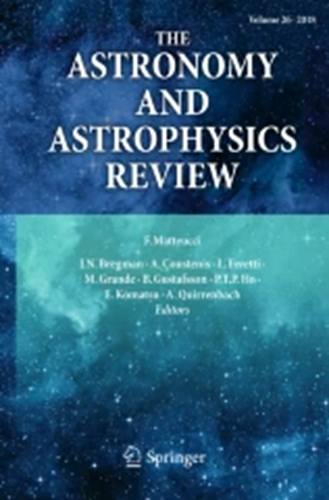在z = 2.47的极紫外光恒星形成星系BOSS-EUVLG1中探测到电离气体流出
IF 26.5
1区 物理与天体物理
Q1 ASTRONOMY & ASTROPHYSICS
引用次数: 3
摘要
BOSS-EUVLG1是迄今为止在宇宙中探测到的紫外线(UV)和Ly $\alpha$最明亮的星系,正在经历一个非常活跃的星暴阶段,形成恒星的速率(SFR)为955 $\pm$ 118 M $_{\odot}$ yr $^{-1}$。我们报告检测到一个广泛的H $\alpha$组件携带25% of the total H$\alpha$ flux. The broad H$\alpha$ line traces a fast and massive ionized gas outflow characterized by a total mass, $\log(M_{out}[M_{\odot}]),$ of 7.94 $\pm$ 0.15, an outflowing velocity (V$_{out}$) of 573 $\pm$ 151 km s$^{-1}$, and an outflowing mass rate ($\dot{M}_{out}$) of 44 $\pm$ 20 M$_{\odot}$ yr$^{-1}$. The presence of the outflow in BOSS-EUVLG1 is also supported by the identification of blueshifted UV absorption lines in low and high ionization states. The energy involved in the H$\alpha$ outflow can be explained by the ongoing star formation without the need for an Active Galactic Nucleus. The derived low mass loading factor ($\eta$= 0.05 $\pm$ 0.03) indicates that although massive, this phase of the outflow can not be relevant for the quenching of the star formation. In addition, only a small fraction ($\leq$ 15%) of the ionized outflowing material with velocities above 372 km s$^{-1}$ could escape the gravitational potential, and enrich the surrounding circum-galactic medium at distances above tens of kpc. The ionized phase of the outflow does not carry the mass and energy to play a relevant role neither in the evolution of the host galaxy nor in the enrichment of the intergalactic medium. Other phases of the outflow could be carrying most of the outflow energy and mass in the form of hot X-ray emitting gas as predicted by some recent simulations. The expected emission of the extended X-ray emitting halo associated with the outflow in BOSS-EUVLG1 and similar galaxies could be detected with the future X-ray observatory, {\it ATHENA} but could not be resolved spatially.本文章由计算机程序翻译,如有差异,请以英文原文为准。
Detection of an ionized gas outflow in the extreme UV-luminous star-forming galaxy BOSS-EUVLG1 at z = 2.47
BOSS-EUVLG1 is the most ultraviolet (UV) and Ly$\alpha$ luminous galaxy detected so far in the Universe, going through a very active starburst phase, and forming stars at a rate (SFR) of 955 $\pm$ 118 M$_{\odot}$ yr$^{-1}$. We report the detection of a broad H$\alpha$ component carrying 25% of the total H$\alpha$ flux. The broad H$\alpha$ line traces a fast and massive ionized gas outflow characterized by a total mass, $\log(M_{out}[M_{\odot}]),$ of 7.94 $\pm$ 0.15, an outflowing velocity (V$_{out}$) of 573 $\pm$ 151 km s$^{-1}$, and an outflowing mass rate ($\dot{M}_{out}$) of 44 $\pm$ 20 M$_{\odot}$ yr$^{-1}$. The presence of the outflow in BOSS-EUVLG1 is also supported by the identification of blueshifted UV absorption lines in low and high ionization states. The energy involved in the H$\alpha$ outflow can be explained by the ongoing star formation without the need for an Active Galactic Nucleus. The derived low mass loading factor ($\eta$= 0.05 $\pm$ 0.03) indicates that although massive, this phase of the outflow can not be relevant for the quenching of the star formation. In addition, only a small fraction ($\leq$ 15%) of the ionized outflowing material with velocities above 372 km s$^{-1}$ could escape the gravitational potential, and enrich the surrounding circum-galactic medium at distances above tens of kpc. The ionized phase of the outflow does not carry the mass and energy to play a relevant role neither in the evolution of the host galaxy nor in the enrichment of the intergalactic medium. Other phases of the outflow could be carrying most of the outflow energy and mass in the form of hot X-ray emitting gas as predicted by some recent simulations. The expected emission of the extended X-ray emitting halo associated with the outflow in BOSS-EUVLG1 and similar galaxies could be detected with the future X-ray observatory, {\it ATHENA} but could not be resolved spatially.
求助全文
通过发布文献求助,成功后即可免费获取论文全文。
去求助
来源期刊

The Astronomy and Astrophysics Review
地学天文-天文与天体物理
CiteScore
45.00
自引率
0.80%
发文量
7
期刊介绍:
The Astronomy and Astrophysics Review is a journal that covers all areas of astronomy and astrophysics. It includes subjects related to other fields such as laboratory or particle physics, cosmic ray physics, studies in the solar system, astrobiology, instrumentation, and computational and statistical methods with specific astronomical applications. The frequency of review articles depends on the level of activity in different areas. The journal focuses on publishing review articles that are scientifically rigorous and easily comprehensible. These articles serve as a valuable resource for scientists, students, researchers, and lecturers who want to explore new or unfamiliar fields. The journal is abstracted and indexed in various databases including the Astrophysics Data System (ADS), BFI List, CNKI, CNPIEC, Current Contents/Physical, Chemical and Earth Sciences, Dimensions, EBSCO Academic Search, EI Compendex, Japanese Science and Technology, and more.
 求助内容:
求助内容: 应助结果提醒方式:
应助结果提醒方式:


